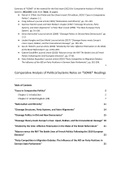Samenvatting
Summary Comparative Analysis of Political Systems Notes on *SOME* Readings - GRADE 6,0
- Vak
- Instelling
- Boek
Summary of *SOME* of the material for the final exam (2022) for Comparative Analysis of Political Systems. INCLUDES notes from (Total: 26 pages): Patrick H. O’Neil, Karl Fields and Don Share’s book (7th edition, 2020) “Cases in Comparative Politics”, chapters 1-2. Craig Calhoun’s jo...
[Meer zien]




